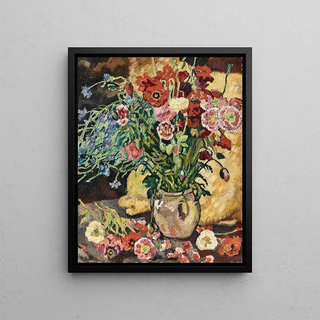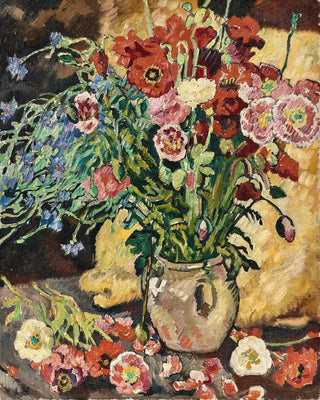Art print | Poppy bouquet - Louis Valtat


View from behind

Frame (optional)
Louis Valtat's "Bouquet of Poppies" is a true ode to floral beauty and the delicacy of colors. This painting, created in the early 20th century, embodies both the essence of the Fauvist movement and the artist's personal sensitivity. The poppies, with their vibrant hues and ephemeral appearance, are here magnified by bold pictorial techniques that transcend mere floral representation to explore deep and universal emotions. Contemplating this artwork, the viewer is immediately transported to a world where light plays with shadows, where each petal seems to vibrate with its own life. It is an invitation to appreciate nature in all its splendor, while being carried away by the visual poetry that Valtat manages to create.
Style and uniqueness of the work
Louis Valtat's style is distinguished by daring use of colors and a dynamic composition. In "Bouquet of Poppies," the reds, oranges, and yellows intertwine with such intensity that they almost seem to pulse on the canvas. The artist does not merely depict flowers; he interprets, transforms them, creating a vibrant atmosphere that evokes movement and life. The blurred contours of the poppies, combined with expressive brushstrokes, give an impression of lightness, as if the bouquet were about to take flight. This free and intuitive approach is characteristic of Fauvism, but it is also tinged with Valtat's personal sensitivity, which seeks to capture not only the appearance of the flowers but also their essence, their soul. Thus, each glance at this work reveals new details, unsuspected nuances, testifying to the richness of the floral universe that the artist has been able to create.
The artist and his influence
Louis Valtat, born in 1869, is a significant figure in French modern art. Operating within a vibrant artistic context, he managed to establish himself through his unique style and his ability to marry tradition and innovation. Influenced by the great Impressionist masters, Valtat also integrated Fauvist principles, seeking to

Matte finish

View from behind

Frame (optional)
Louis Valtat's "Bouquet of Poppies" is a true ode to floral beauty and the delicacy of colors. This painting, created in the early 20th century, embodies both the essence of the Fauvist movement and the artist's personal sensitivity. The poppies, with their vibrant hues and ephemeral appearance, are here magnified by bold pictorial techniques that transcend mere floral representation to explore deep and universal emotions. Contemplating this artwork, the viewer is immediately transported to a world where light plays with shadows, where each petal seems to vibrate with its own life. It is an invitation to appreciate nature in all its splendor, while being carried away by the visual poetry that Valtat manages to create.
Style and uniqueness of the work
Louis Valtat's style is distinguished by daring use of colors and a dynamic composition. In "Bouquet of Poppies," the reds, oranges, and yellows intertwine with such intensity that they almost seem to pulse on the canvas. The artist does not merely depict flowers; he interprets, transforms them, creating a vibrant atmosphere that evokes movement and life. The blurred contours of the poppies, combined with expressive brushstrokes, give an impression of lightness, as if the bouquet were about to take flight. This free and intuitive approach is characteristic of Fauvism, but it is also tinged with Valtat's personal sensitivity, which seeks to capture not only the appearance of the flowers but also their essence, their soul. Thus, each glance at this work reveals new details, unsuspected nuances, testifying to the richness of the floral universe that the artist has been able to create.
The artist and his influence
Louis Valtat, born in 1869, is a significant figure in French modern art. Operating within a vibrant artistic context, he managed to establish himself through his unique style and his ability to marry tradition and innovation. Influenced by the great Impressionist masters, Valtat also integrated Fauvist principles, seeking to






